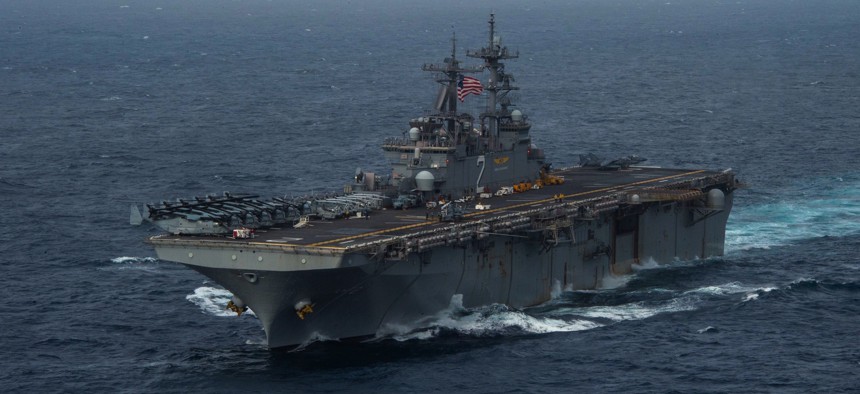
The amphibious assault ship USS Essex (LHD 2) transits the Arabian Sea, Sept. 13, 2021. U.S. Navy / Mass Communication Specialist 2nd Class Brett McMinoway
We Need More Amphibs, and We Need to Buy Them Smarter
Buying amphibious warships one at a time has left us with too few, and little prospect of closing the gap.
Amphibious warships are like no other ships in the U.S. Navy. By law, they are the nation’s “9-1-1” force, to be most ready when the nation is least ready. From crisis response and disaster relief to defending allies and deterring adversaries, amphibious warships are the “Swiss Army Knives” of our fleet. They can launch a variety of aircraft and landing craft, can carry a full contingent of battle-ready Marines anywhere in the world, and are the ideal first responders in humanitarian crises due to their expansive cargo space, water-production capabilities, and unmatched hospital and trauma facilities.
But unfortunately, we have too few. This was demonstrated in February, as Russia prepared to invade Ukraine and the head of the U.S. European Command asked for an amphibious ready group to deploy a few weeks early. The U.S. Navy and Marine Corps could not meet this request—and could not even deploy by its original date.
If the Navy is going to expand its amphibious fleet from the current 28 to the 31 that the Marine Corps says it needs, the administration and the Pentagon must buy more and at a faster rate. This will require, among other factors, the administration to drop its reluctance to order multiple warships at once.
We see the benefits of bulk buying in our daily life—such as grocery shopping, where we find it is always more economically savvy to buy a carton of eggs, not 12 individual eggs at separate times. But when it comes to warships, administrations and lawmakers have generally purchased just one at time, preferring, as the Congressional Research Service recently put it, to retain “flexibility for making changes – especially reductions – in procurement programs in future years in response to changing strategic or budgetary circumstances.”
This preference has made the industrial base more fragile and undermined our nation’s ability to deter adversaries.
By contrast, multi-ship purchases enable companies to plan for the future; to hire, train and retain a skilled workforce; to invest in new equipment, facilities, and technology; and maximize the material procurement savings benefited through economic order quantity, procurement, and materials. Ship production lines perform best and with far less risk when they follow a steady line of production. For example, the Navy saved $700M by buying 10 destroyers at one time, rather than buying these ships individually.
The Biden administration’s latest long-range shipbuilding plan nodded to the value of a multi-ship buy to the health of the supplier base, noting that “reduced procurement levels, inefficient profiles and production gaps could impact specific portions of the shipbuilding industrial base.” But the plan would also push acquisition of the next generation of LPD ship—LPD(X)—to 2041, leaving a 16-year gap between the construction of amphibious warships. As Lt. Gen. Karsten Heckl, Deputy Commandant for Combat Development and Integrated told Congress last week, “Amphibious warfare ships are being decommissioned faster than they are procured, delivered, and eventually available for employment.”
The Marine Corps’ requirement remains 31 amphibious ships – 10 big-deck LHAs and 21 LSDs or LPDs – which industry experts say should be constructed on four-year and two-year centers falls short of that. From 2023 to 2027, the Navy has requested money for exactly one amphibious ship. Decommissionings will shrink the amphib fleet to 25 ships.
Earlier this year, the Amphibious Warship Industrial Base Coalition surveyed shipbuilders and their suppliers; nine out of 10 said multi-ship purchases are important to the health and future of their company. Eight out of 10 suppliers said extended intervals between builds would significantly increase product and service prices, and almost half said this would mean they would have to reduce their workforce. Therefore, the industrial base understands the value of multi-ship buy.
Congressional members who have voiced concerns about the Administration’s shipbuilding plan now have the opportunity to replace it with a better one if they understand the value of multi-ship procurement. So, now the real question remains: will they?
Capt. David Forster, a retired U.S. Navy captain, is chairman for the Amphibious Warship Industrial Base Coalition (AWIBC), which represents businesses that build, make parts for, and service U.S. amphibious warships.



